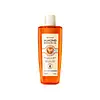What's inside
What's inside
 Key Ingredients
Key Ingredients

 Benefits
Benefits

 Concerns
Concerns

 Ingredients Side-by-side
Ingredients Side-by-side

Caprylic/Capric Triglyceride
MaskingPrunus Amygdalus Dulcis Oil
Skin ConditioningMipa-Laureth Sulfate
CleansingLaureth-4
EmulsifyingCocamide DEA
EmulsifyingMichelia Alba Flower Oil
MaskingParfum
MaskingPhenoxyethanol
PreservativeCandida Bombicola/Glucose/Methyl Rapeseedate Ferment
AntimicrobialOlea Europaea Fruit Oil
MaskingHelianthus Annuus Seed Oil
EmollientArgania Spinosa Kernel Oil
EmollientAngelica Gigas Root Extract
Skin ConditioningLithospermum Erythrorhizon Root Extract
Skin ConditioningGlycyrrhiza Uralensis Root Extract
Skin ConditioningBHT
AntioxidantCaprylic/Capric Triglyceride, Prunus Amygdalus Dulcis Oil, Mipa-Laureth Sulfate, Laureth-4, Cocamide DEA, Michelia Alba Flower Oil, Parfum, Phenoxyethanol, Candida Bombicola/Glucose/Methyl Rapeseedate Ferment, Olea Europaea Fruit Oil, Helianthus Annuus Seed Oil, Argania Spinosa Kernel Oil, Angelica Gigas Root Extract, Lithospermum Erythrorhizon Root Extract, Glycyrrhiza Uralensis Root Extract, BHT
Water
Skin ConditioningCocamidopropyl Betaine
CleansingSodium C16 Olefin Sulfonate
EmulsifyingCocos Nucifera Water
MaskingCandida Bombicola/Glucose/Methyl Rapeseedate Ferment
AntimicrobialSodium Hyaluronate
HumectantNiacinamide
SmoothingOlea Europaea Fruit Oil
MaskingLithospermum Erythrorhizon Root Extract
Skin ConditioningHelianthus Annuus Seed Oil
EmollientGlycyrrhiza Uralensis Root Extract
Skin ConditioningArgania Spinosa Kernel Oil
EmollientAngelica Gigas Root Extract
Skin ConditioningSodium PCA
HumectantManganese PCA
HumectantAscorbyl Glucoside
AntioxidantMagnesium PCA
HumectantZinc PCA
HumectantPhenoxyethanol
PreservativeSodium Cocoyl Isethionate
CleansingSodium Benzoate
MaskingPEG-150 Distearate
EmulsifyingTetrasodium Glutamate Diacetate
Water, Cocamidopropyl Betaine, Sodium C16 Olefin Sulfonate, Cocos Nucifera Water, Candida Bombicola/Glucose/Methyl Rapeseedate Ferment, Sodium Hyaluronate, Niacinamide, Olea Europaea Fruit Oil, Lithospermum Erythrorhizon Root Extract, Helianthus Annuus Seed Oil, Glycyrrhiza Uralensis Root Extract, Argania Spinosa Kernel Oil, Angelica Gigas Root Extract, Sodium PCA, Manganese PCA, Ascorbyl Glucoside, Magnesium PCA, Zinc PCA, Phenoxyethanol, Sodium Cocoyl Isethionate, Sodium Benzoate, PEG-150 Distearate, Tetrasodium Glutamate Diacetate
 Reviews
Reviews

Ingredients Explained
These ingredients are found in both products.
Ingredients higher up in an ingredient list are typically present in a larger amount.
We don't have a description for Angelica Gigas Root Extract yet.
You may know this ingredient as argan oil. Argan Oil has antioxidant, hydrating, and soothing properties.
Studies have shown argan oil can help fight again radical damage from the sun. This makes it effective at preventing hyperpigmentation.
Large amounts of vitamin E found in argan oil helps the skin retain water. Argan oil also contains fatty acids such as linoleic acid, oleic acid, and palmitic acid. It is also a good source of lipids.
Another benefit of argan oil is skin-soothing. It can help reduce inflammation-related skin symptoms.
Argan Oil is effective at regulating sebum production in pores. This can make it effective at treating hormonal acne.
Traditionally, argan oil was used for its antibacterial and antifungal properties. However, argan oil contains fatty acids that may make it not fungal-acne safe.
Argan Trees are native to Morocco.
Learn more about Argania Spinosa Kernel OilWe don't have a description for Candida Bombicola/Glucose/Methyl Rapeseedate Ferment yet.
Glycyrrhiza Uralensis Root Extract comes from Chinese licorice. This plant is native to Asia and used in Chinese traditional medicine. Chinese licorice root contains antioxidants and polysaccharides.
Antioxidants may help with anti-aging by neutralizing free-radical molecules. Polysaccharides help moisturize the skin due to their ability to mimic our natural skin barrier.
Helianthus Annuus Seed Oil is the oil derived from the seeds of a Sunflower. Sunflower seed oil is non-fragrant. It is an emollient, meaning it helps to soften the skin.
Sunflower seed oil contains many fatty acids. The fatty acids found in sunflower seeds include (from highest amount to least): linoleic acid, myristic acid, palmitic acid, stearic acid, arachidic acid, oleic acid, and linolenic acid.
These fatty acids help the skin create ceramides. Ceramides play a role in repairing the skin barrier.
Helianthus Annuus Seed Oil helps moisturize the skin. This in turn helps the skin look more rejuvenated and smoother.
Sunflowers are rich in vitamin E.
Historians believe Indigenous cultures of North America domesticated sunflowers before corn. Thus they relied on sunflower oil for a variety of uses. One such use is moisturizing skin and hair.
Sunflower seed oil may not be fungal acne safe. We recommend speaking with a professional if you have any concerns.
Learn more about Helianthus Annuus Seed OilLithospermum Erythrorhizon Root Extract comes from the roots of the Lithospermumerythrorhizon plant, or the purple gromwell plant.
Studies show this root extract has anti-inflammatory properties and protects against oxidative stress. It also displayed UV absorption capability and protection against UV-B damage. However, it should not replace your sunscreen.
The dried roots of this plant are used in traditional Chinese and Japanese medicine due to its antiviral properties.
Learn more about Lithospermum Erythrorhizon Root ExtractOlea Europaea Fruit Oil is the fixed oil obtained from the ripe fruit of the Olive. In other words - olive oil.
The primary contents of olive oil are glycerides of the fatty acids linoleic, oleic and palmitic.
Olive oil also contains antioxidants such as Vitamin E. Antioxidants may help reduce signs of aging by fighting unstable free-radical molecules. It also contains Vitamins A (retinol), D, and K.
The squalene in olive oil makes it a great emollient. Emollients help soothe and soften your skin by trapping moisture in. This makes olive oil a great skin moisturizer.
Studies show olive oil to have antibacterial and antifungal properties in low concentrations. Another study found olive oil irritated sensitive oily skin. We always recommend speaking with a professional about using this ingredient in your routine.
Due to the fatty acid content, this ingredient may not be fungal-acne safe.
Learn more about Olea Europaea Fruit OilPhenoxyethanol is a preservative that has germicide, antimicrobial, and aromatic properties. Studies show that phenoxyethanol can prevent microbial growth. By itself, it has a scent that is similar to that of a rose.
It's often used in formulations along with Caprylyl Glycol to preserve the shelf life of products.